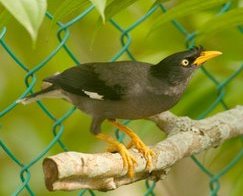The ubiquitous Javan Myna
 The Javan Myna (Acridotheres javanicus), formerly known as White-vented Myna, was brought into Singapore around 1920. Since then it has become very successful, especially in urban areas. The aggressive nature of this introduced myna has successfully displaced the once common Common Myna (A. tristis). Margie Hall laments the fact that back in the 1990s she used to see a group of up to ten Common Mynas by the beach at Sembawang Park, but for the last five or six years she only saw a couple or couple and immatures. And around Singapore she wonders whether anyone has ever seen more than a couple.
The Javan Myna (Acridotheres javanicus), formerly known as White-vented Myna, was brought into Singapore around 1920. Since then it has become very successful, especially in urban areas. The aggressive nature of this introduced myna has successfully displaced the once common Common Myna (A. tristis). Margie Hall laments the fact that back in the 1990s she used to see a group of up to ten Common Mynas by the beach at Sembawang Park, but for the last five or six years she only saw a couple or couple and immatures. And around Singapore she wonders whether anyone has ever seen more than a couple. Indeed, the Javan Myna is extremely adaptable in terms of food and breeding sites. Our bird specialist, R. Subaraj, reports that it wakes up well before other birds to feast on road kills along our expressways. S.K. Kwan mentions that some 11 years ago she saw a myna making its nest slotted between the wall and the building signage at Magazine Road. They usually nest in the eves of house, as Margie rightly points out. She further adds: "They are seen going in and out the holes between beams in the above ground MRT line at Sembawang."
My experience with this myna is in my garden. Whenever I do weeding, turn the compost or repot root-bound plants, there will always be at least one pair following me. Apparently these birds take the opportunity to catch insects and other invertebrates my activities invariably uncover. I am not the only person to notice this as Margie has similar experience in her garden. She further notes that the birds are always present whenever grass cutters are around.
These birds remind me of the Cattle Egrets (Bubulcus ibis) that were always around cattle that once roamed freely along our roads. But such a scene is no more, ever since the government long ago issued a veiled threat to round up the cattle, slaughter them and distribute the meat to charity homes.
Javan Mynas are scavengers and never miss an opportunity for a free meal. K.F. Yap reports his observations around Housing and Development Board’s apartment blocks. When cleaners empty the garbage bins each morning, huge flocks gather around. There will always be House Crows (Corvus splendens) too, but these shy birds will station themselves at a safe distance away. Only after the bins have been replaced and the bin-doors closed, and well after the cleaners have gone to the next garbage chute and the mynas have left the scene, will these crows fly in to forage.
Margie Hall adds her observations: “There is (or was for several years until recently, but then I have not made the turning at the same time as a garbage truck in the last few months) a group of five or six Javan Mynas who hang around Yishun Avenue 1 near the junction with Sembawang Road, where there is an extra right hand lane for traffic to wait for the right hand turn. Garbage trucks en route to Senoko regularly drive along Yishun Avenue 1, stopping at the junction in order to wait for the right hand turn. The mynas fly onto the back of the garbage trucks to see what they can find. As the trucks move forward to make the turn, the mynas stay on them. Only when the trucks have done the complete right hand turn and are accelerating on Sembawang Road do the mynas fly off the trucks and fly back to the trees near the waiting lane, to wait for the next truck!”
Jeffrey Low recalls seeing mynas doing something similar to fruit and vegetable trucks along the North-South Highway in Malaysia. They hop on and rummage through the fruits and vegetables until the trucks (presumably) rolls out of their territory or comfort zone before they hop off.
Contributors: K.F. Yap, Margie Hall, Jeffrey Low, S.K. Kwan and R. Subaraj.
Labels: Species



4 Comments:
The bald mynas can be due to moulting, but I will have to consult our resident ornithologist. Toeless, I am not sure? Magpie Robin's decline can be due to the bird-cage trade. It was actively reintroduced a decade or so ago and is now relatively common in urban areas. Thanks for the visit and comments, Budak.
I've been seeing quite a number of common mynahs at East Coast Park near the sailing centre actually. In fact, on one of the days when I was rollerblading in the area, they actually out-numbered the black Javan Mynahs. Over 20 of them together on a small grass area, felt almost like they were holding a conference. And that's not counting those hopping around in the nearby grass areas.
Mynahs have been spread to New Zealand, however their actual distribution is unknown. Would there be any reliable sources with information on that?
Sorry, I have no information - unless someone else is knowledgeable.
Please check out our new site:
http://besgroup.talfrynature.com/
Post a Comment
<< Home